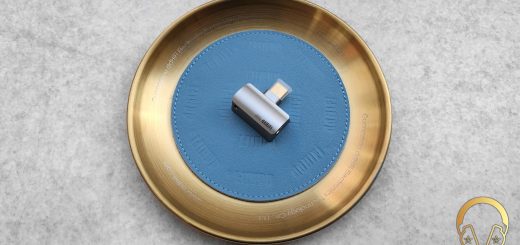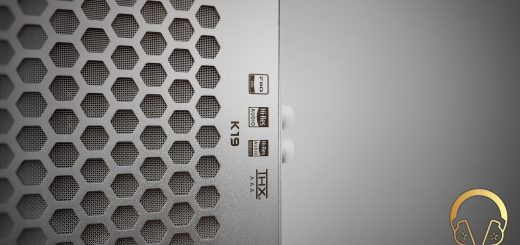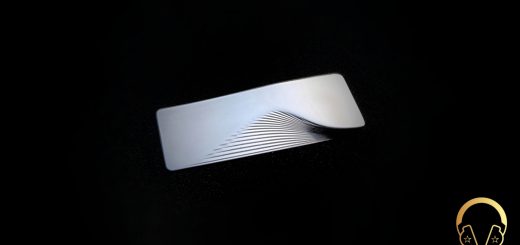ddHiFi Eye3 (TC44Pro E3) Review
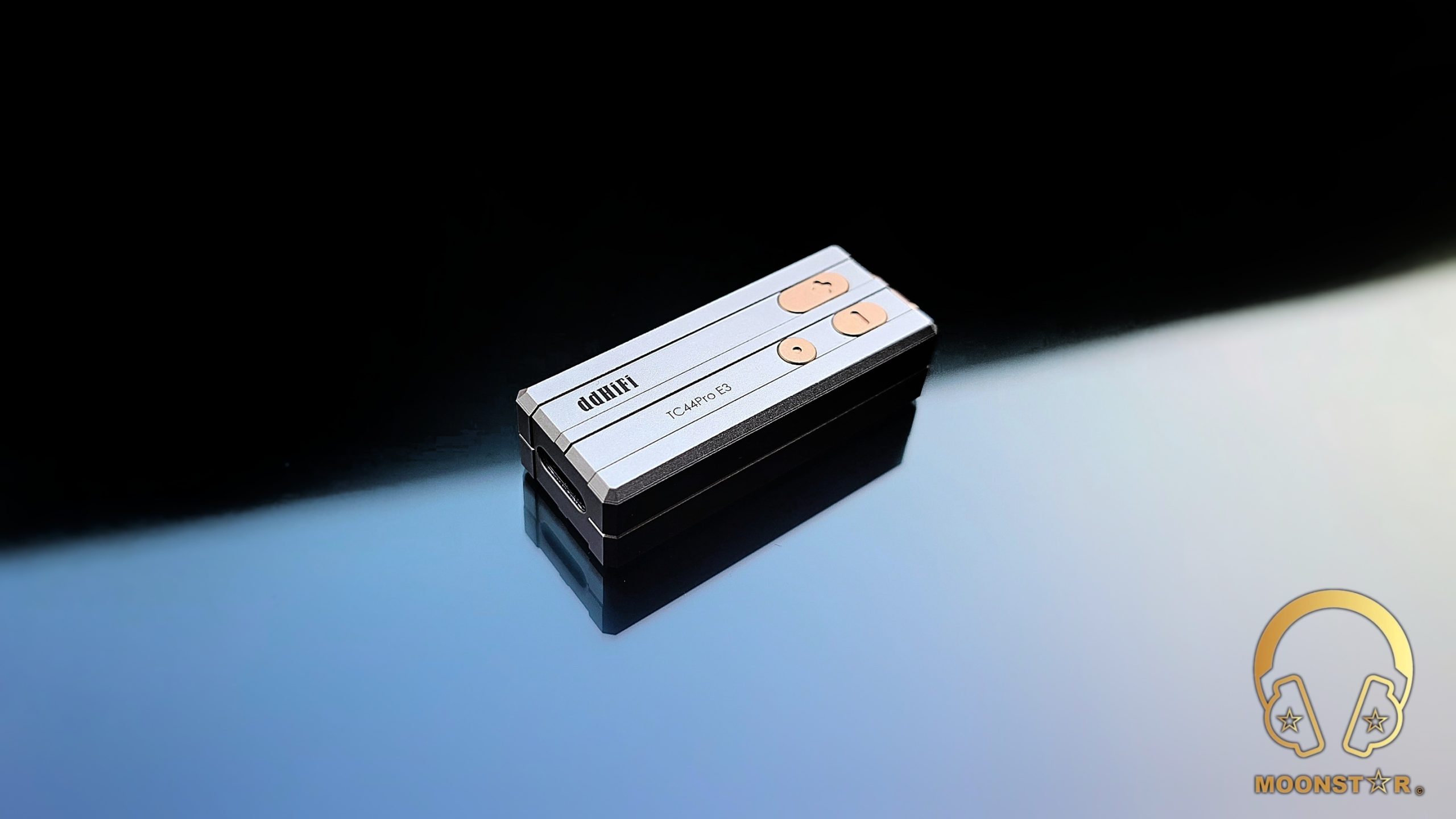
ddHiFi Eye3 (TC44Pro E3) Review
Introduction:
The ddHiFi Eye3, representing the third generation of ddHiFi’s portable DAC and amplifier adapters (also known as the TC44Pro E3), aims to deliver high-resolution audio performance in a highly portable form factor. Suitable for users seeking improved sound quality from smartphones, tablets, or computers without the bulk of larger audio gear, it builds on previous models with dual DAC chips and enhanced amplification, focusing on balanced output capabilities and user-friendly controls. In this review, we examine its design, features, and audio performance to provide a comprehensive assessment for audiophiles considering a dongle-style solution.
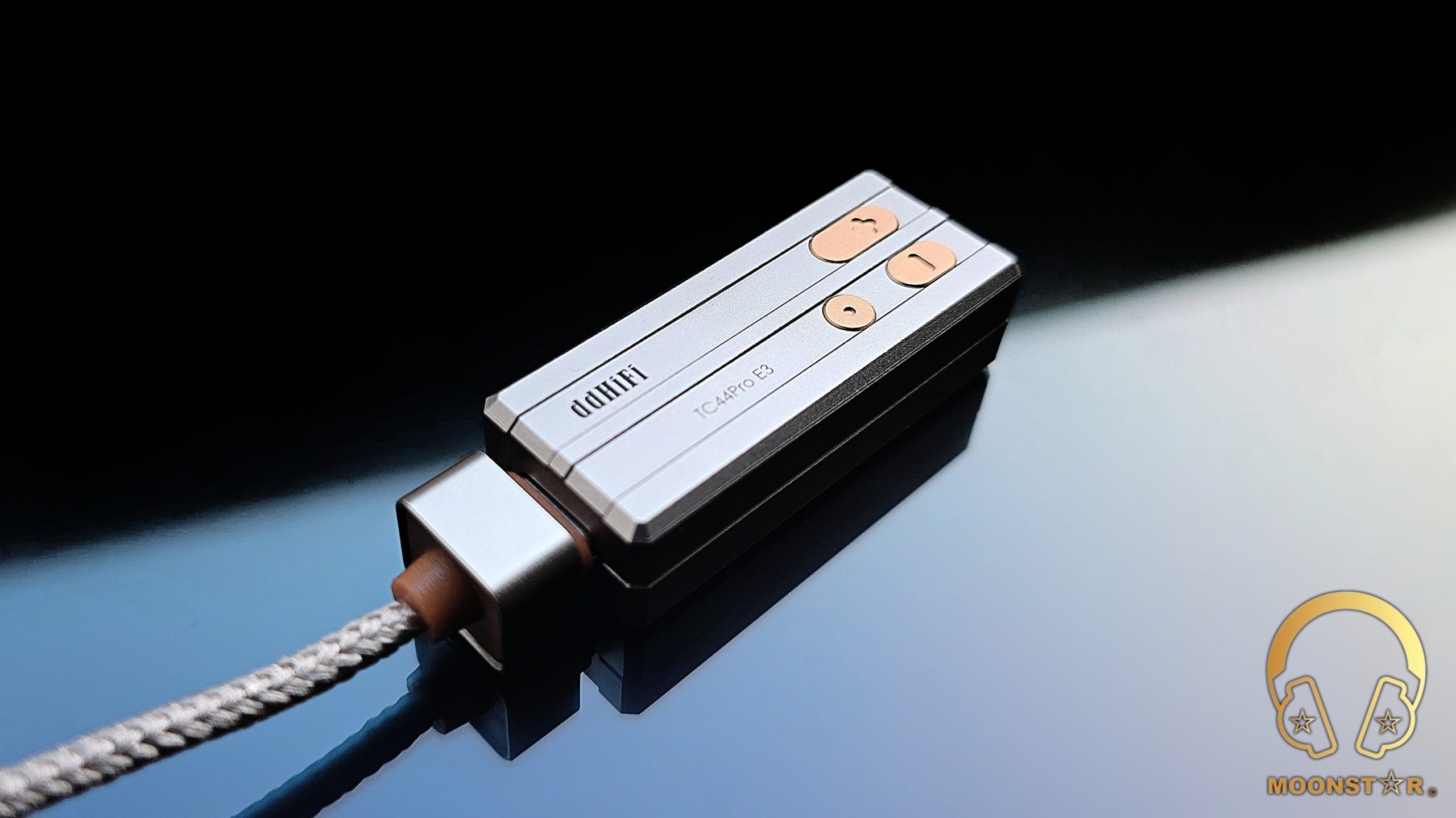
Disclaimer:
I would like to thank ddHiFi for providing me Eye3 (TC44Pro E3) sample for review purposes. I am not affiliated with ddHiFi beyond this review and these words reflect my true, unaltered opinions about the product.
Price & Availability:
The ddHiFi Eye3 (TC44Pro E3) is priced around $105,99USD, positioning it in the mid-range segment of portable DAC/AMP dongles. More information’s can be found under the link below;
Package & Accessories:
The packaging for the Eye3 is straightforward and functional, arriving in a compact box that reflects the device’s emphasis on portability.
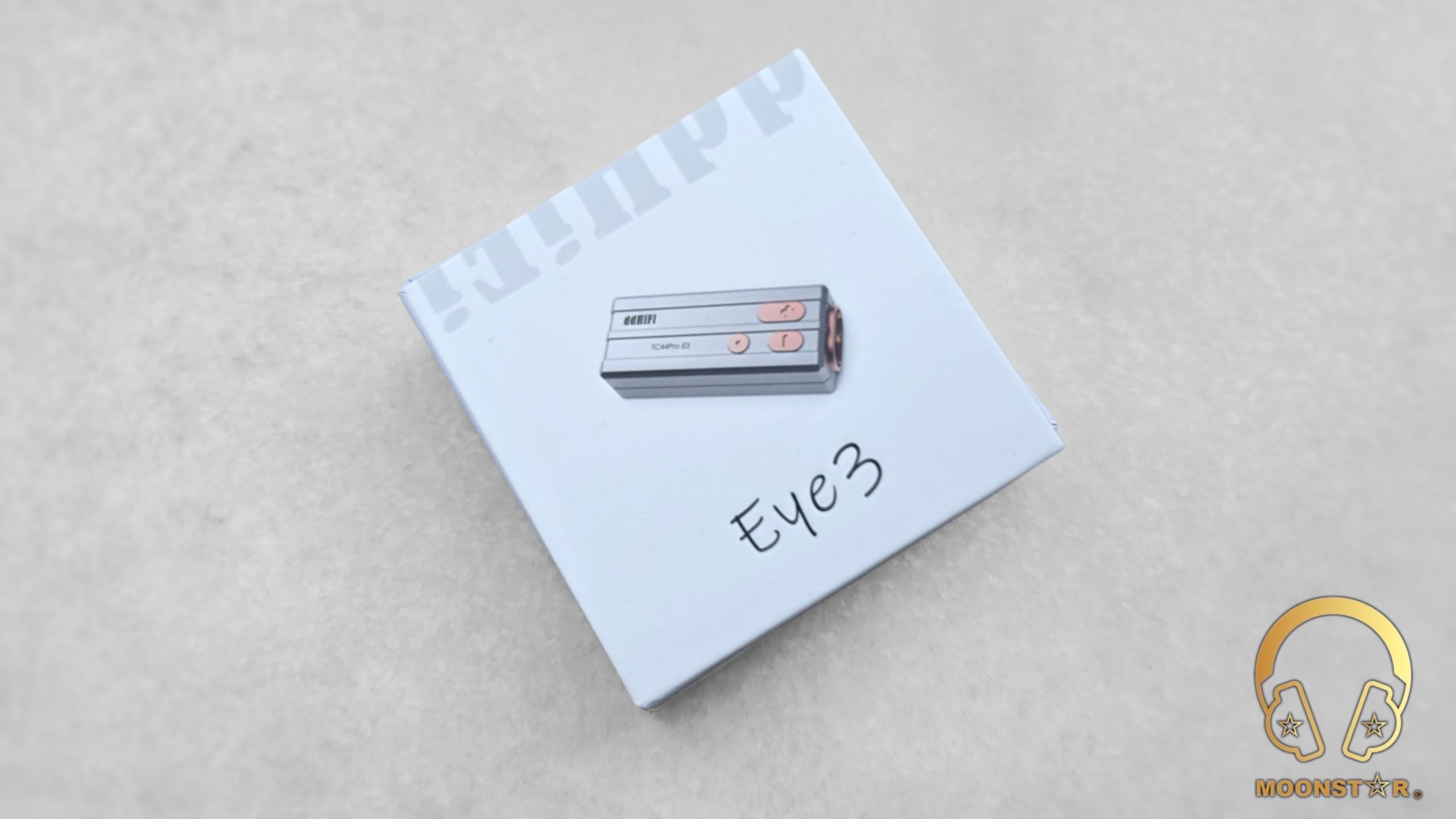
Inside, users will find the main unit itself, along with a short USB-C to USB-C cable designed for OTG use. This cable, identified as the TC03SS model, supports quick connections to source devices and can be swapped for longer or angled variants if needed. No additional items such as carrying cases or adapters are included, keeping the unboxing experience minimalistic and focused on essentials. The overall presentation prioritizes efficiency over extravagance, aligning with the product’s practical design philosophy.
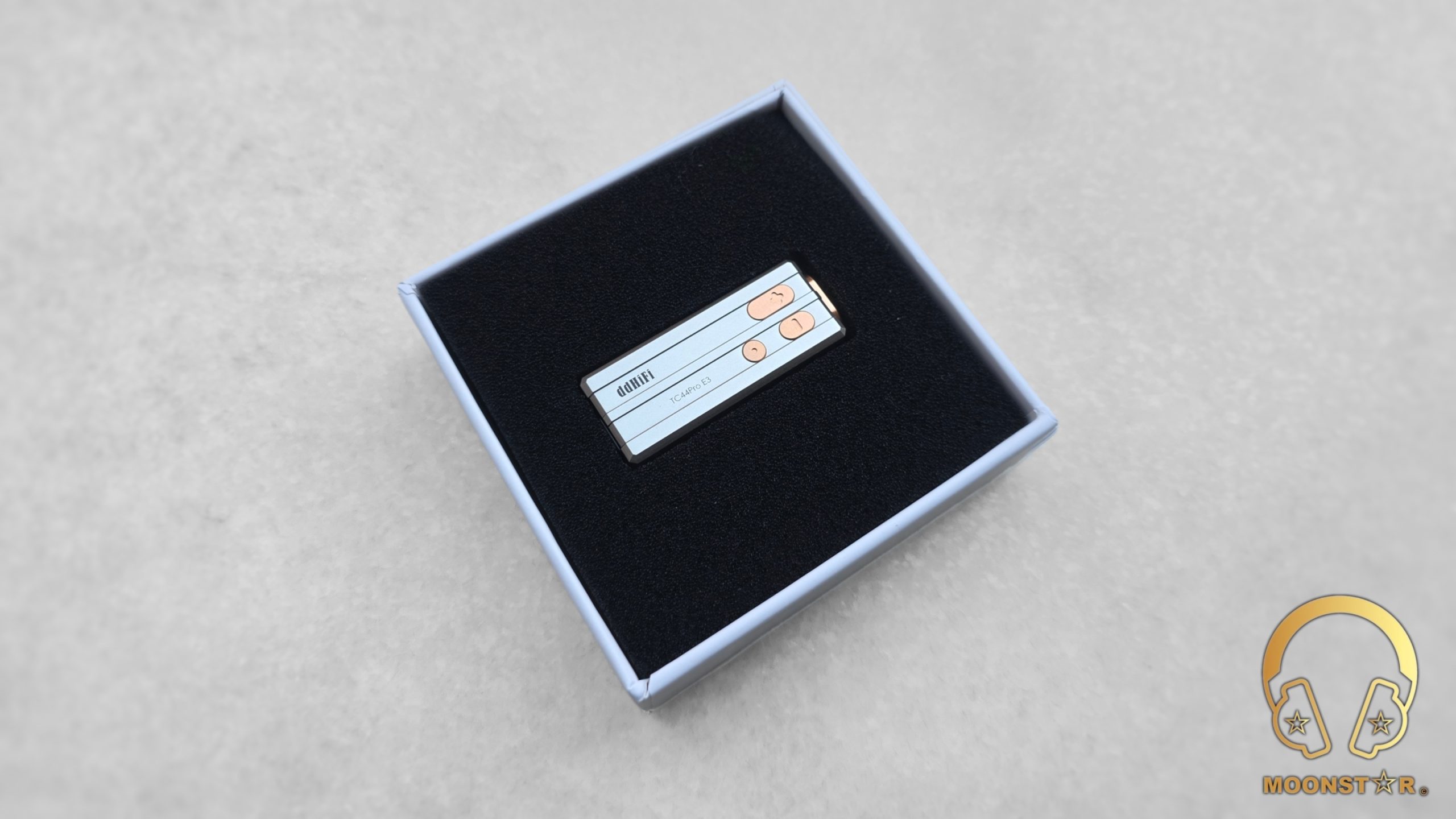
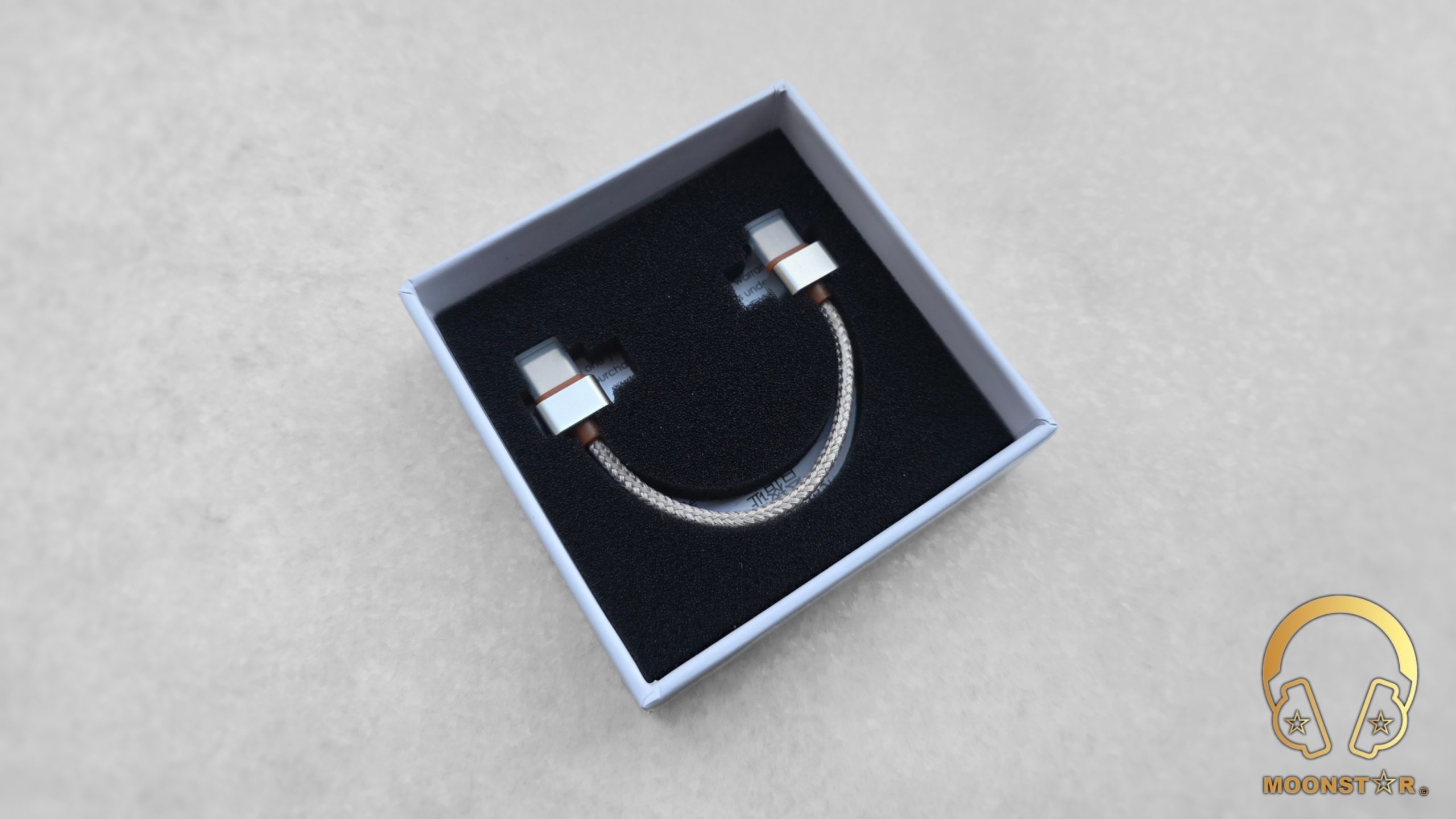
Design and Build Quality:
The Eye3 features a sleek, rectangular design with a robust, two-tone finish combining a metallic silver body with copper-colored accents, giving it a premium yet understated aesthetic. Measuring approximately 44.3mm in length, 17.5mm in width, and 11.6mm in thickness, and weighing just 13.6 grams, it remains one of the smallest dongle DAC/AMP units in its class, enhancing its portability.

The chassis is crafted from high-quality aluminum with a matte finish, complemented by copper alloy accents around the ports, ensuring durability and a premium tactile feel with no noticeable flex or creaks.
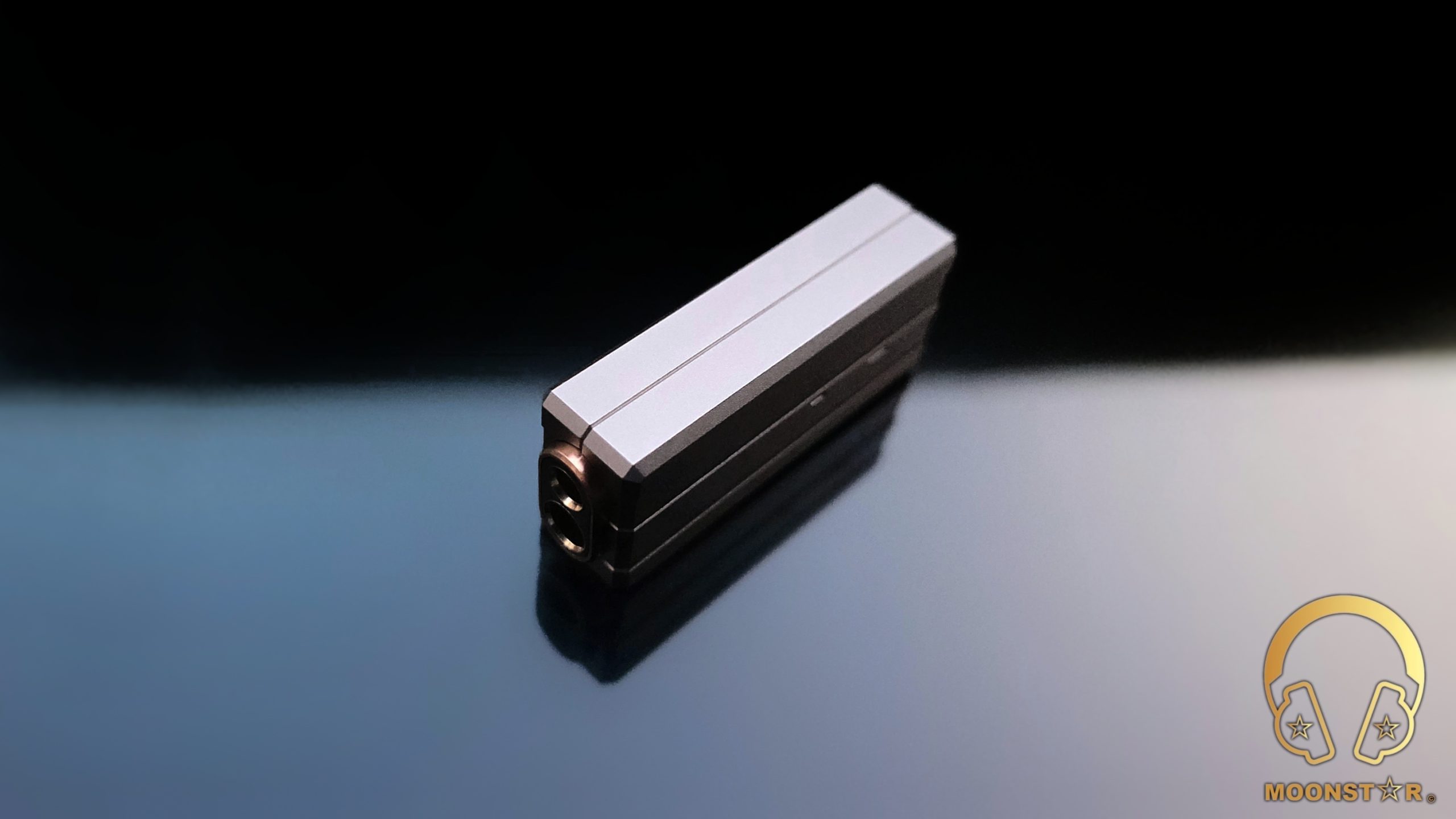
The front surface is clean and functional, featuring the “ddHiFi” branding engraved at the top edge and the model designation “Eye3” below it (with “TC44Pro E3) subtly noted in smaller text). It includes two small, tactile buttons in a contrasting copper color, labeled with “+” and “−” symbols for volume control, offering 60 steps of precise adjustment. These buttons are flush with the surface, ensuring ease of use without protruding awkwardly when connected to a device.

The sides of the device are smooth and featureless, maintaining a streamlined profile that fits comfortably during use.
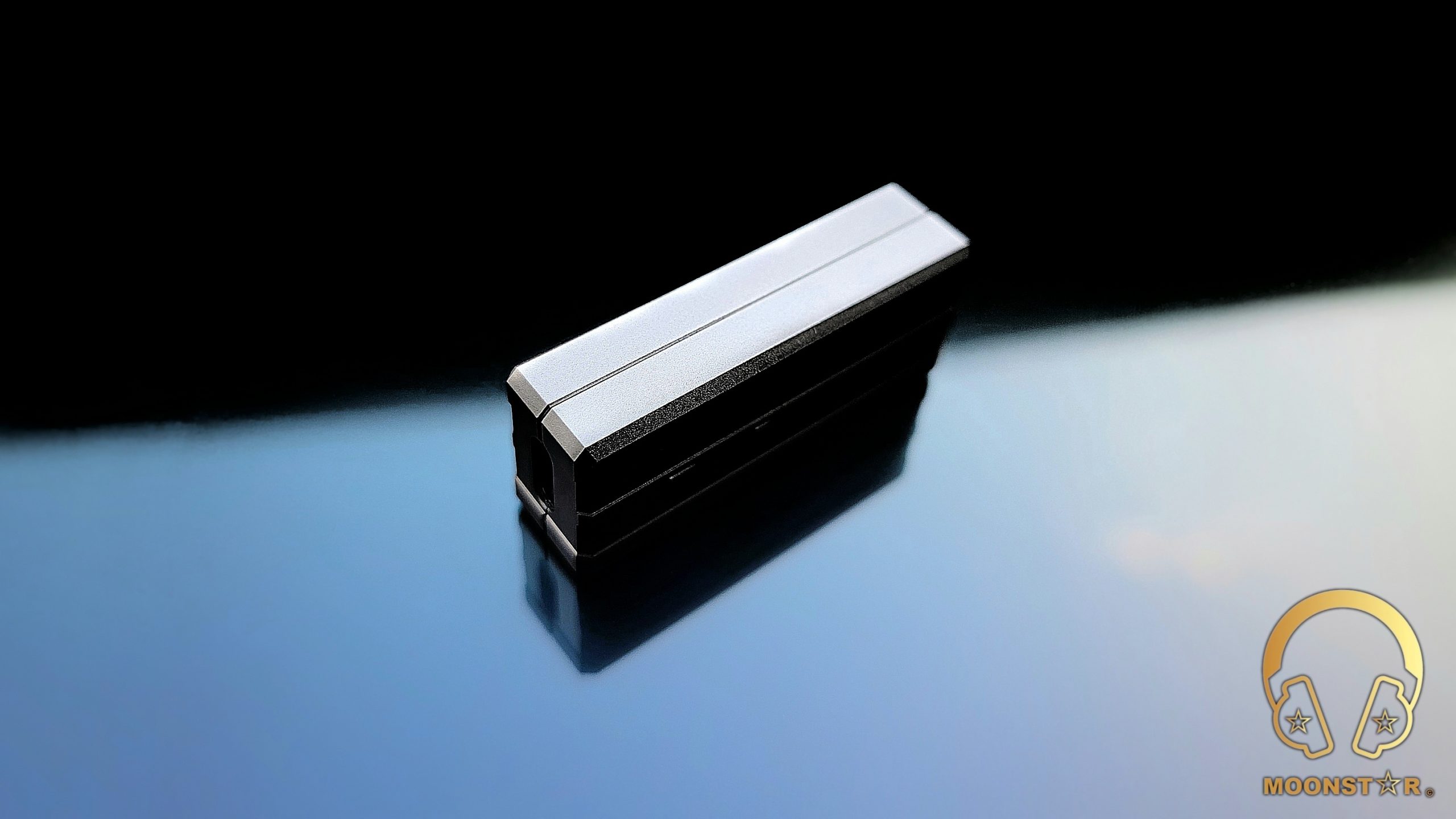
On the bottom, the dual headphone outputs, a 3.5mm single-ended jack and a 4.4mm balanced jack, are housed within a recessed, copper-ringed port, providing a secure connection with a refined look.
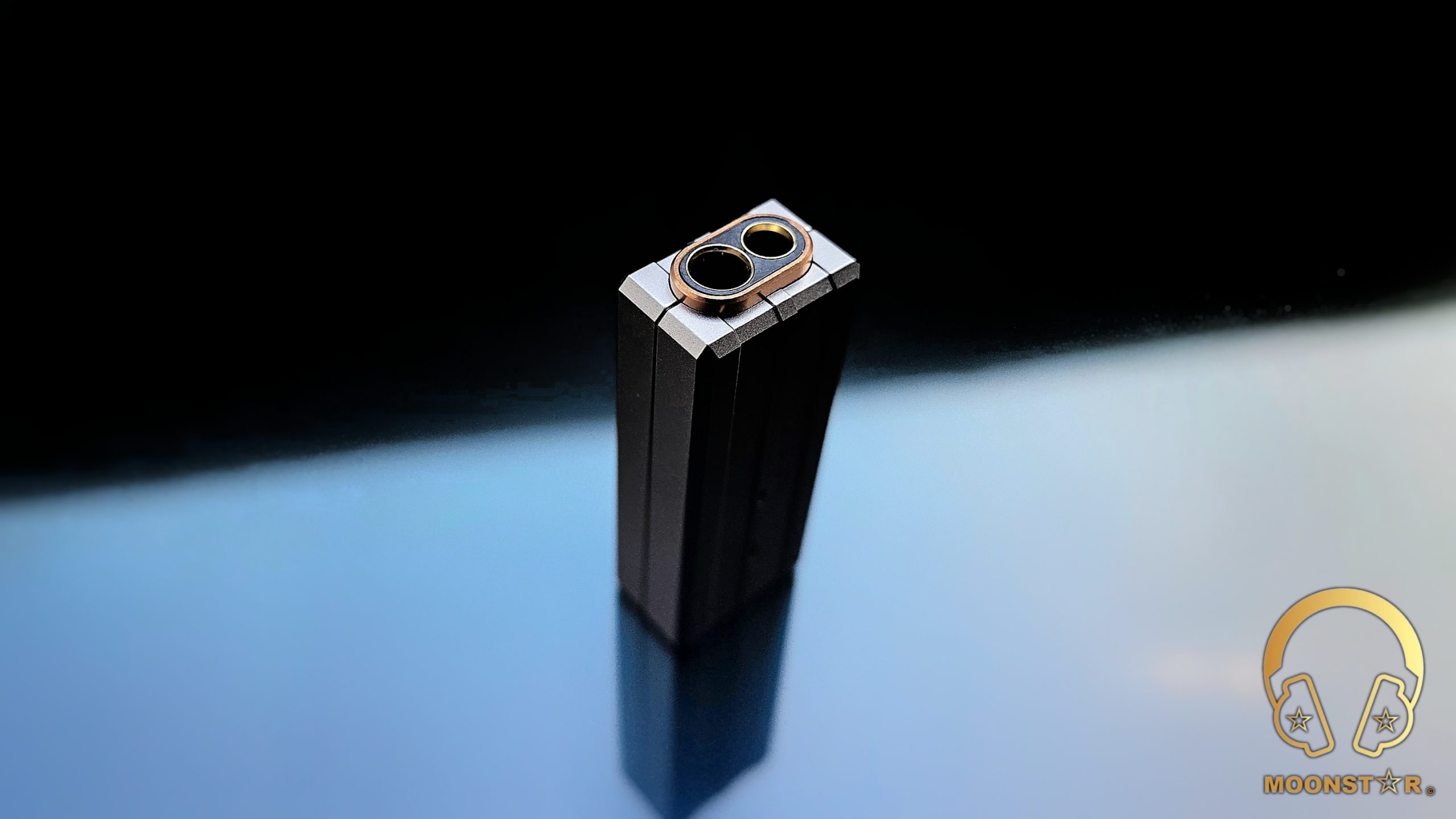
The top surface includes a USB-C input port, designed to accommodate interchangeable cables for added flexibility, and is finished with a matching copper accent.
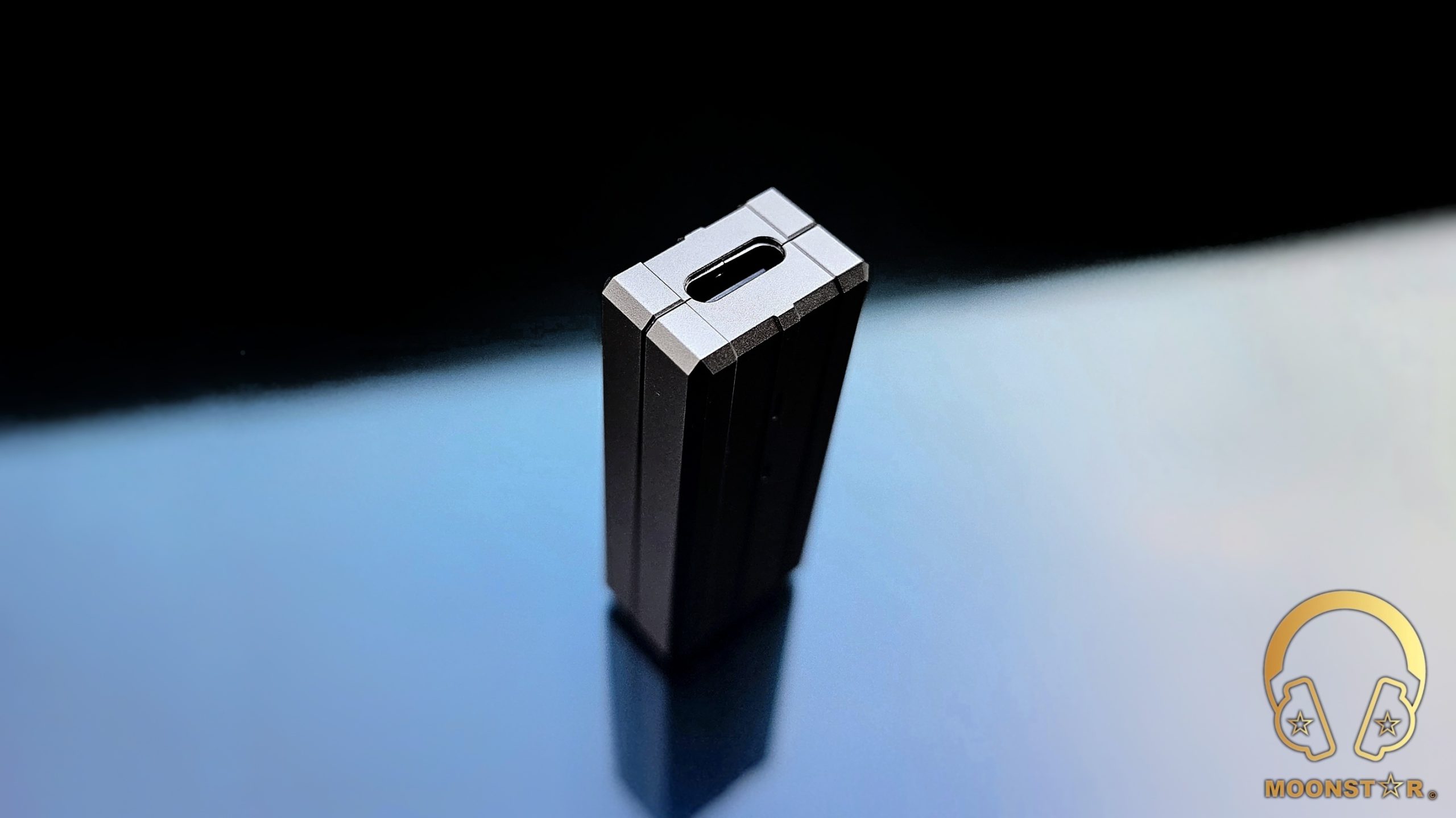
The rear surface serves as the functional hub, featuring a gain switch labeled “GAIN” in white text, with a tactile copper-colored button that toggles between standard and high-output modes. This is accompanied by three indicator lights, blue for PCM, green for DSD, and yellow for high-gain mode, embedded in a small, circular arrangement, providing clear visual feedback on the device’s operational status.
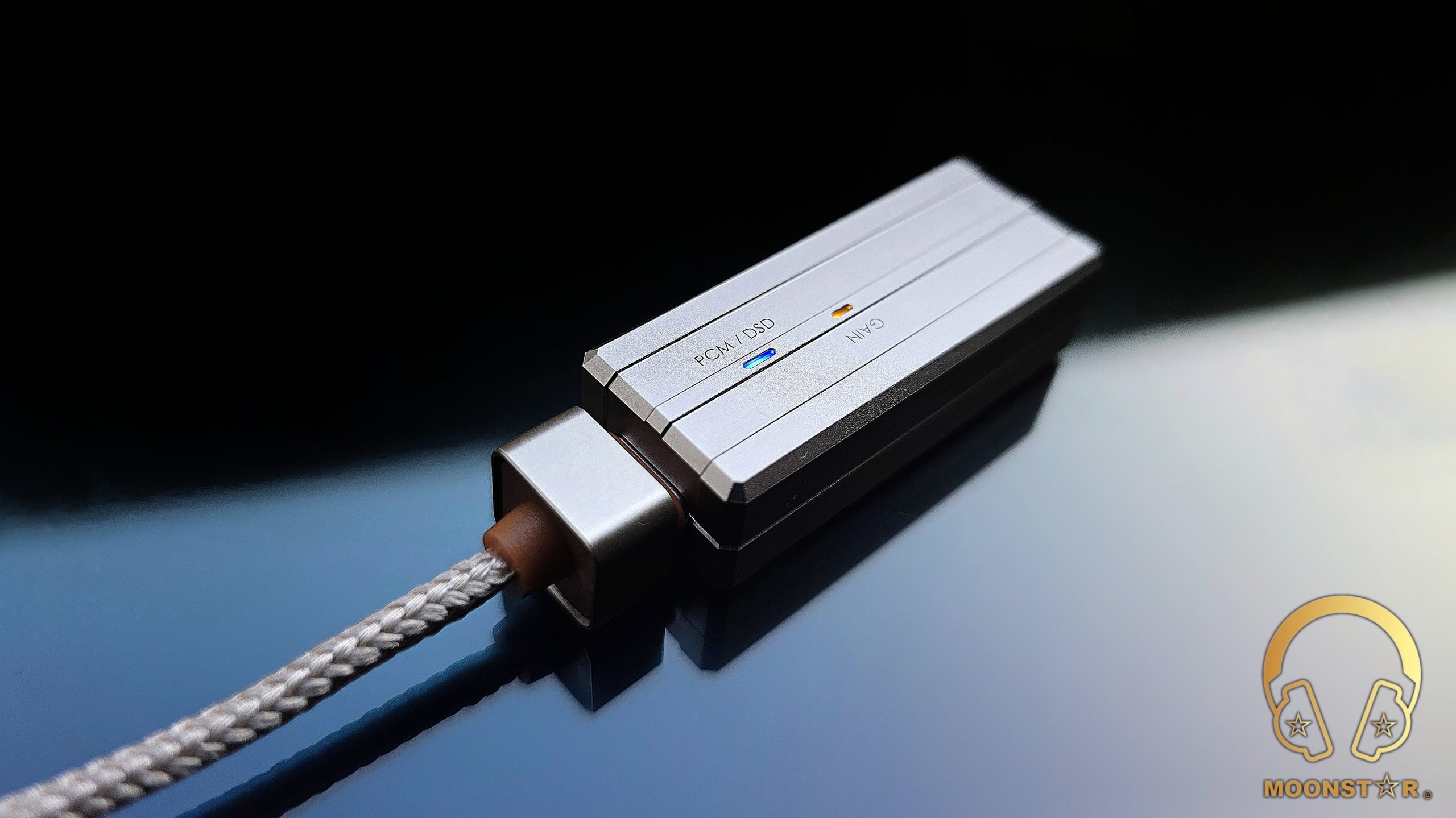
The overall build quality is exceptional, with seamless integration of components and a premium feel that belies its compact size, making it an attractive option for on-the-go audiophiles.
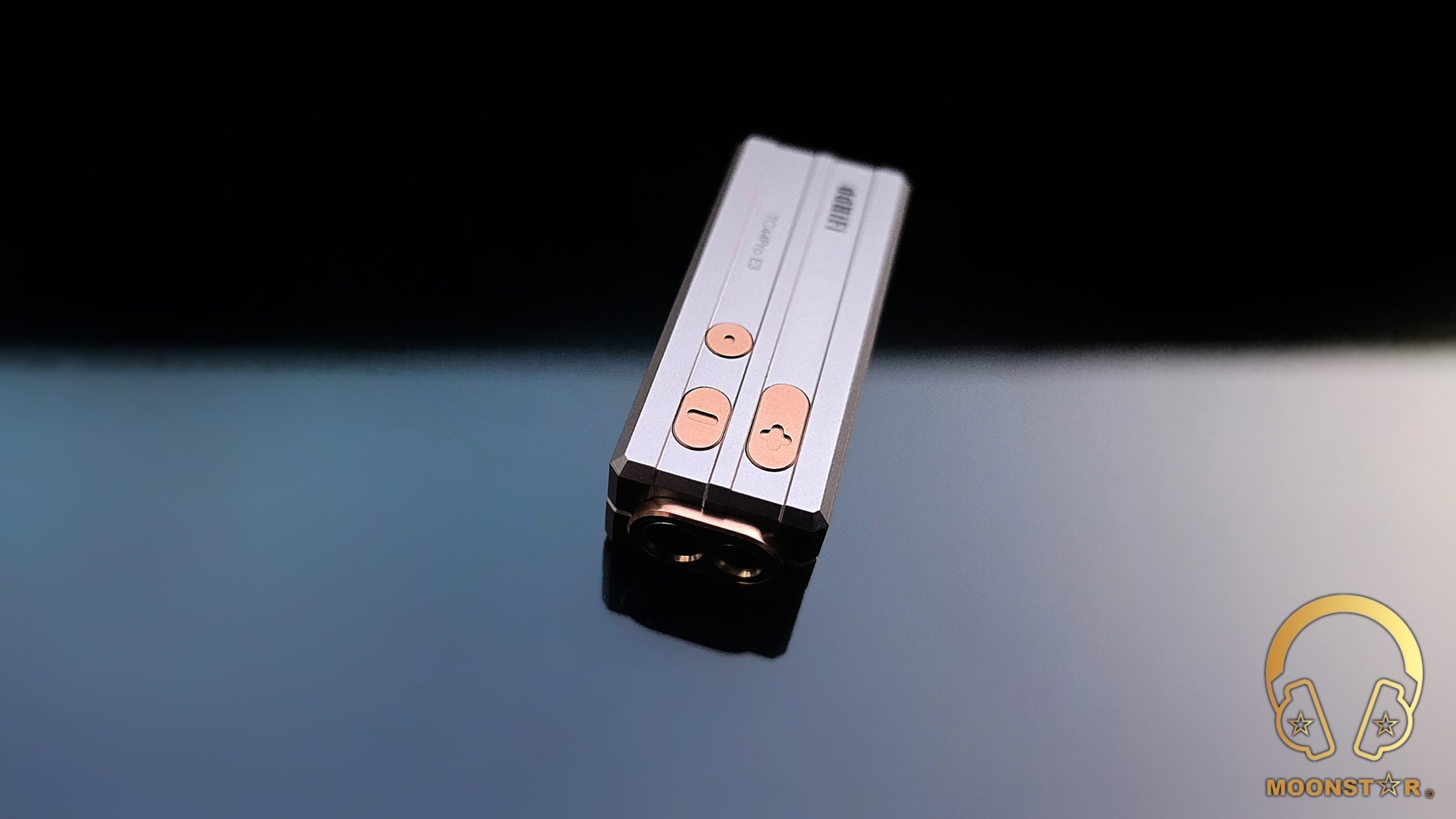
Low Profile Cables:
The Eye3 comes equipped with the TC03SS low-profile USB-C cable as part of its standard package, featuring a slim, flexible design with a braided exterior in a neutral gray tone for durability and minimal bulk. The connectors are reinforced with aluminum housings, matching the device’s copper accents, and offer a straight plug configuration that ensures a secure connection.
At approximately 10cm in length, it provides a discreet link to source devices like the Samsung Galaxy Tab S8 Ultra or MSI Vector GP68HX, supporting high-speed data transfer and power delivery without signal degradation.
Optionally, users can purchase the TC03SL cable, which features a straight plug on one end and an L-shaped plug on the other for improved ergonomics, or the TC03LL cable, with both ends designed as L-shaped connectors to reduce strain in tight spaces. These optional cables enhance versatility for different setups, catering to preferences for portability and convenience.
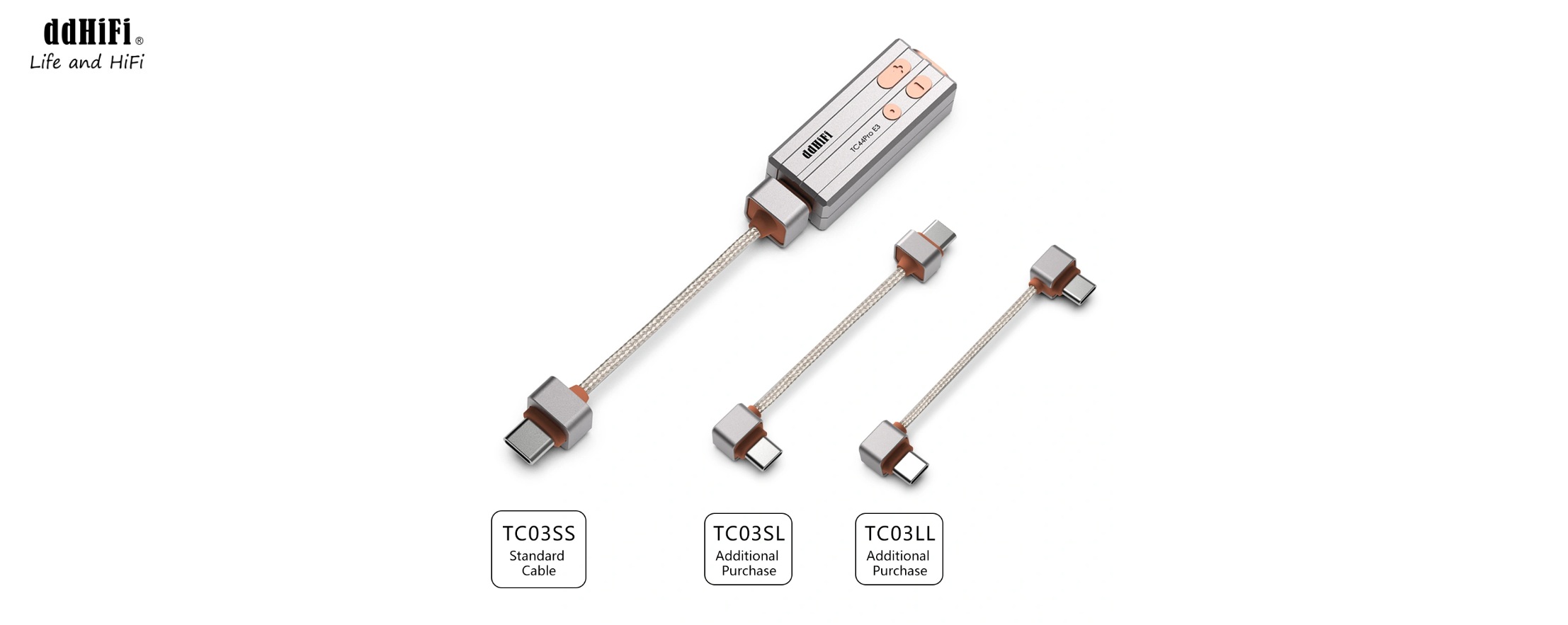
Technical Specifications:
- Model: Eye3 (TC44 Pro E3)
- DAC Chips: Dual Cirrus Logic CS43198 chips for high-fidelity decoding.
- Amplifier Chips: Dual SGM8262-2 amplifiers to handle output demands.
- Output Power: Up to 510mW at 32Ω load via the 4.4mm balanced port in high-gain mode; 175mW at 32Ω via the 3.5mm single-ended port.
- Output Voltage: 4Vrms balanced and 2.35Vrms single-ended in high-gain mode.
- Supported Audio Formats: PCM up to 32-bit/384kHz; native DSD64, DSD128, and DSD256.
- Frequency Response: Wide range suitable for high-resolution audio playback.
- Connectivity: USB-C input with OTG support; compatible with Android, iOS, Windows, and macOS devices.
- Power Consumption: Efficient design to minimize drain on source device batteries.
- Dimensions and Weight: 44.3 x 17.5 x 11.6 mm; 13.6g.
Hardware Features:
DAC & Amplification:
At the heart of the Eye3 are the dual CS43198 DAC chips, known for their low distortion and high dynamic range. These are paired with dual SGM8262-2 amplifier chips, which provide ample power for driving in-ear monitors (IEMs) and even some over-ear headphones. The amplification stage focuses on clean signal delivery, with channel isolation that helps maintain separation in stereo imaging. The device supports seamless switching between audio formats, ensuring compatibility with a wide array of high-resolution files.
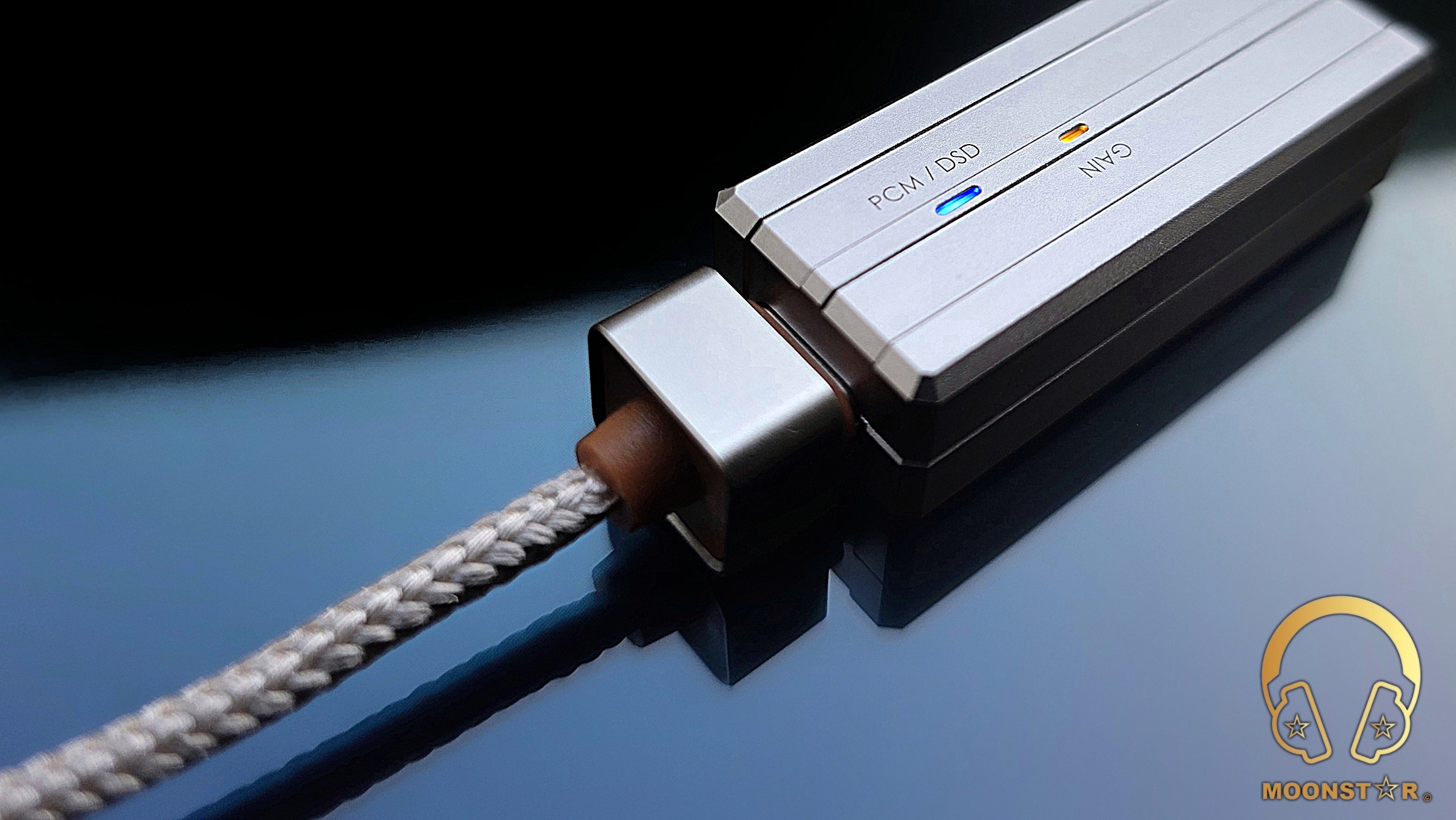
Volume and Gain Controls:
The 60-step volume adjustment, controlled via the copper-colored “+” and “−” buttons on the front, allows for precise level matching, reducing the need for software-based controls that can introduce artifacts. The gain switch, located on the rear, boosts output for more demanding loads with a tactile copper button, with the indicator lights providing clear feedback. This feature is particularly useful when transitioning between sensitive IEMs and higher-impedance headphones.
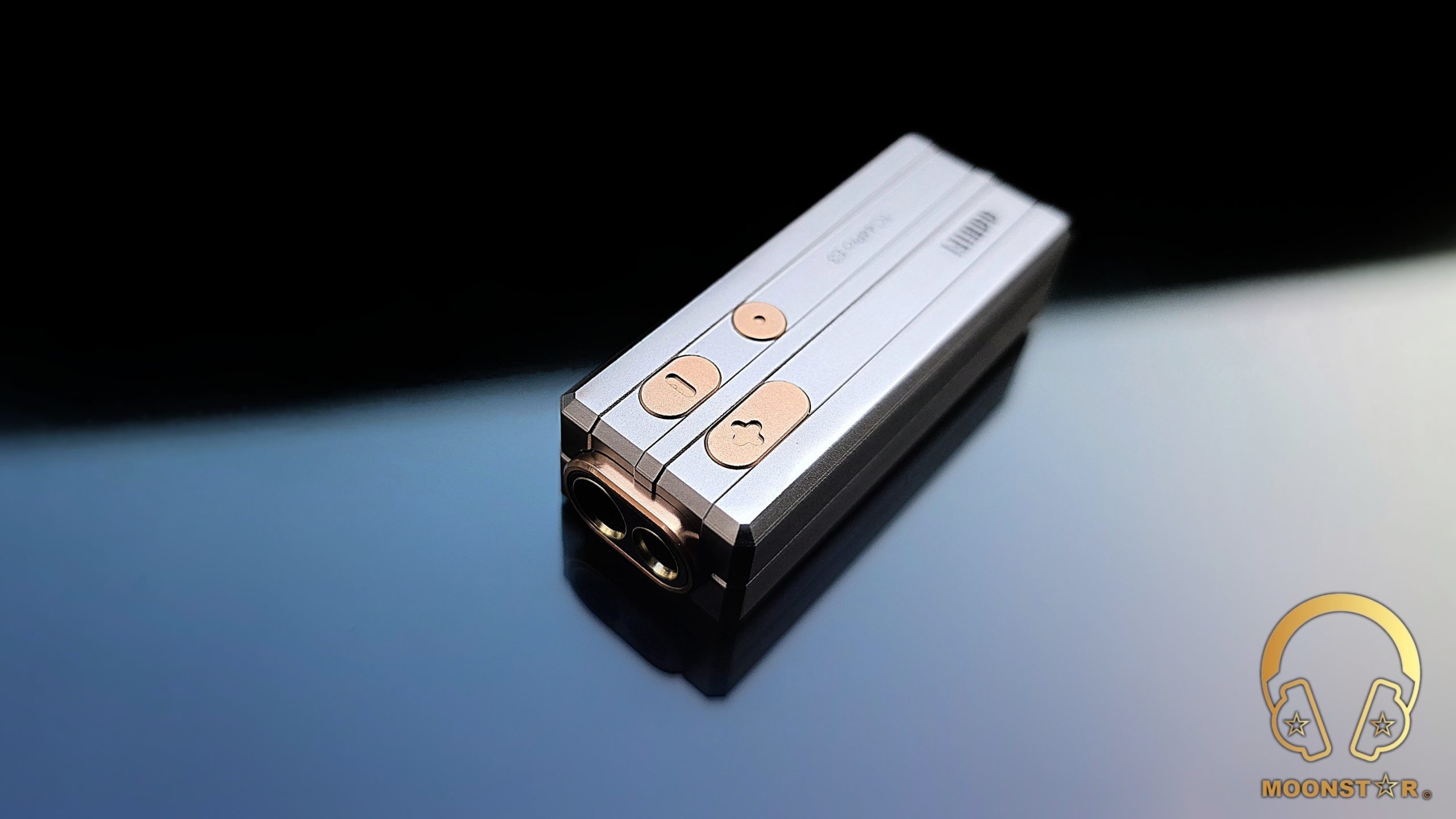
Connectivity & Audio Support:
The USB-C interface enables plug-and-play operation across multiple platforms, with no dedicated app required for basic functionality. Audio support includes high-bitrate PCM and native DSD decoding, making it suitable for audiophile libraries. While it lacks advanced features like Bluetooth or EQ presets, the focus remains on core audio processing without unnecessary complexity.
Battery Impact:
As a dongle, the Eye3 draws power from the connected source device. In testing, it exhibits moderate power consumption, allowing for extended sessions on smartphones without rapid battery depletion. High-gain mode increases draw slightly, but overall efficiency is commendable for its output capabilities.
Equipments used for this review:
- DAC’s : ddHiFi TC44 Pro
- Source Devices : Samsung Galaxy Tab S8 Ultra, MSI Vector GP68HX
- IEMs : ddHiFi Surface, Moondrop Harmon
- Cables : Stock TC03SS low-profile USB Type-C cable
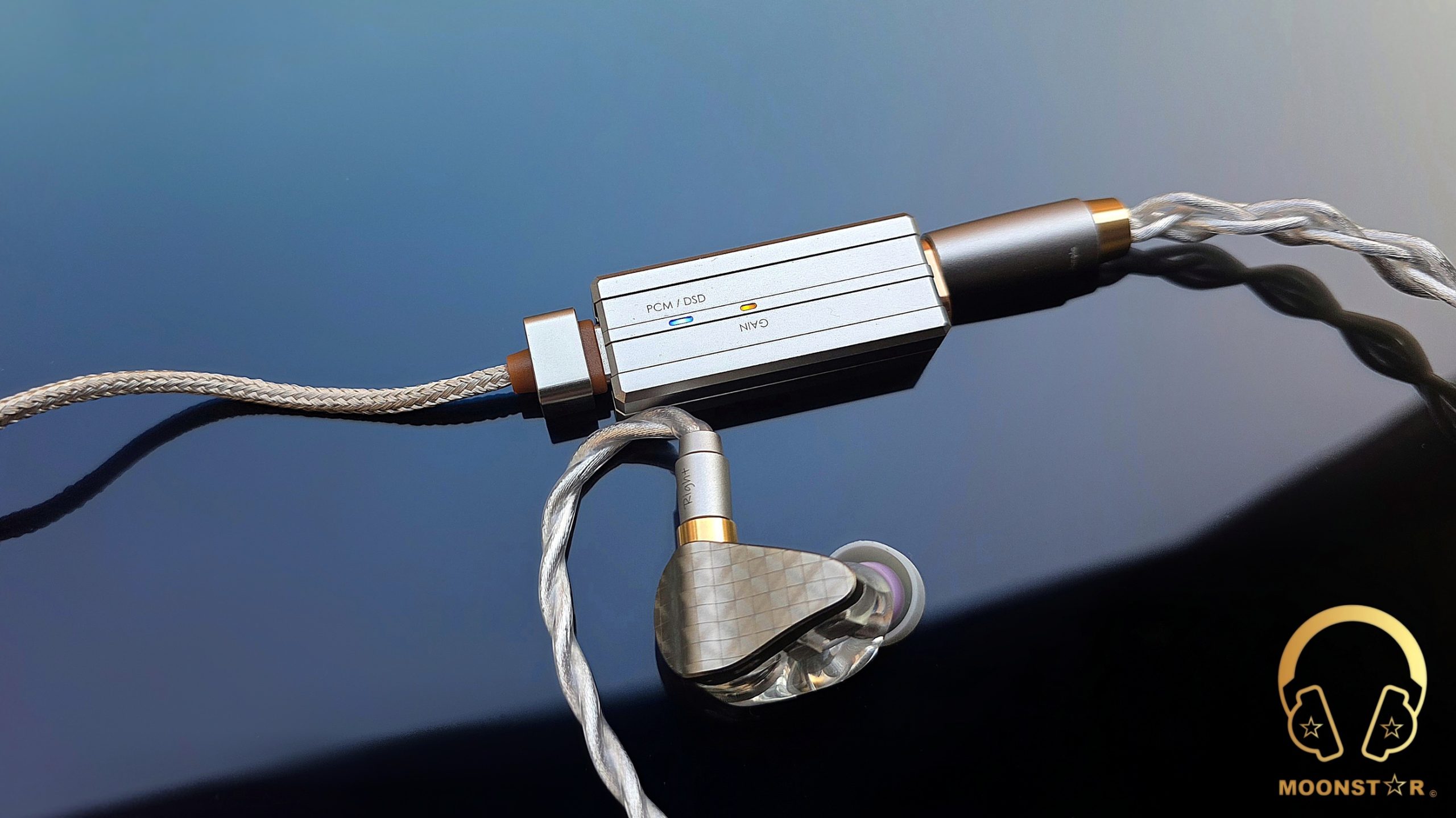
Albums & tracks used for this review:
- Adele – My Little Love (Spotify)
- Randy Crawford – On Day I Will Fly Away (Flac 16bit/44.1kHz)
- Hayley Westenra – Odyssey Album (Dezzer HiFi)
- Dionne Warwick – Walk On By (Flac 16bit/44.1kHz)
- Sarah McLachlan – Angel (Flac 24bit/48kHz)
- Sertap Erener – Aşk (Flac 16bit/44.1kHz)
- Edith Piaf – Non Je Ne Regrette Rien (Flac 16bit/44.1kHz)
- Diana Krall – So Wonderful (DSF)
- Aretha Franklin – I Say A Little Payer (Flac 24bit/96kHz)
- David Bowie – Heroes (Flac 24bit/192kHz)
- Elton John – Rocket Man ((Flac 24bit/96kHz)
- Barry White – Just The Way You Are (Flac 24bit/48kHz)
- Isaac Hayes – Walk On By (Flac 16bit/44.1kHz)
- Sting – Englishman in New York – (Flac 24bit/48kHz)
- Eric Clapton – Wonderful Tonight (Flac 24bit/96kHz)
- B.B. King – Riding With The King (Tidal Hi-Fi)
- Dave Gahan – Kingdom (Tidal Hi-Fi)
- U2 – Sunday Bloody Sunday (Flac 16bit/44.1kHz)
- Bro Safari, UFO! – Drama (Deezer HiFi)
- Armin Van Buuren – Vini Vici (Flac 16bit/44.1kHz)
- Really Slow Motion – Deadwood (Deezer HiFi)
- Jo Blankenburg – Meraki (Spotify)
- Lorde – Royal (Flac 24bit/48kHz)
- Toutant – Rebirth (Deezer HiFi)
- Gogo Penguin – Raven (Flac 24bit/192kHz)
- Portishead – It Could Be Sweet (Spotify)
- Charly Antolini – Duwadjuwandadu (Flac 24bit/192kHz)
- Michael Jackson – Billie Jean (Flac 24bit/192kHz)
- Ferit Odman – Look, Stop & Listen (Flac 24bit/192kHz)
- Chopin – Nocturn No. 20 In C-Sharp Minor (Flac 16bit/44.1kHz)
- Fazıl Say – Nazım Oratoryosu (Live) (Flac 16bit/44.1kHz)
- Vivaldi – Le QuarttroStagioni “The Four Season” (Deezer HiFi)
- Otto Liebert& Luna Negra – The River (Flac 24bit/192kHz)
- Lunatic Soul – The Passage (Flac 16bit/44.1kHz)
- Deftones – My Own Summer (Shove it) (Flac 16bit/44.1kHz)
- Photek – The Hiden Camera (Spotify)
- Muse – Hysteria (Flac 24bit/48kHz)
- Metallica – Sad but True (Flac 24bit/96kHz)
- Opeth – Windowpane (Flac 16bit/44.1kHz)
- Megadeth – Sweating Bullets (Tidal Hi-Fi)
- Rush – YYZ (Flac 16bit/44.1kHz)
- Rush – Leave That Thing Alone (Flac 16bit/44.1kHz)
- Slayer – Angel of Death (Spotify)s
- Liquid Tension Experiment 2 – Acid Rain (Spotify)
- Yosi Horikawa – Bubbles (Spotify)
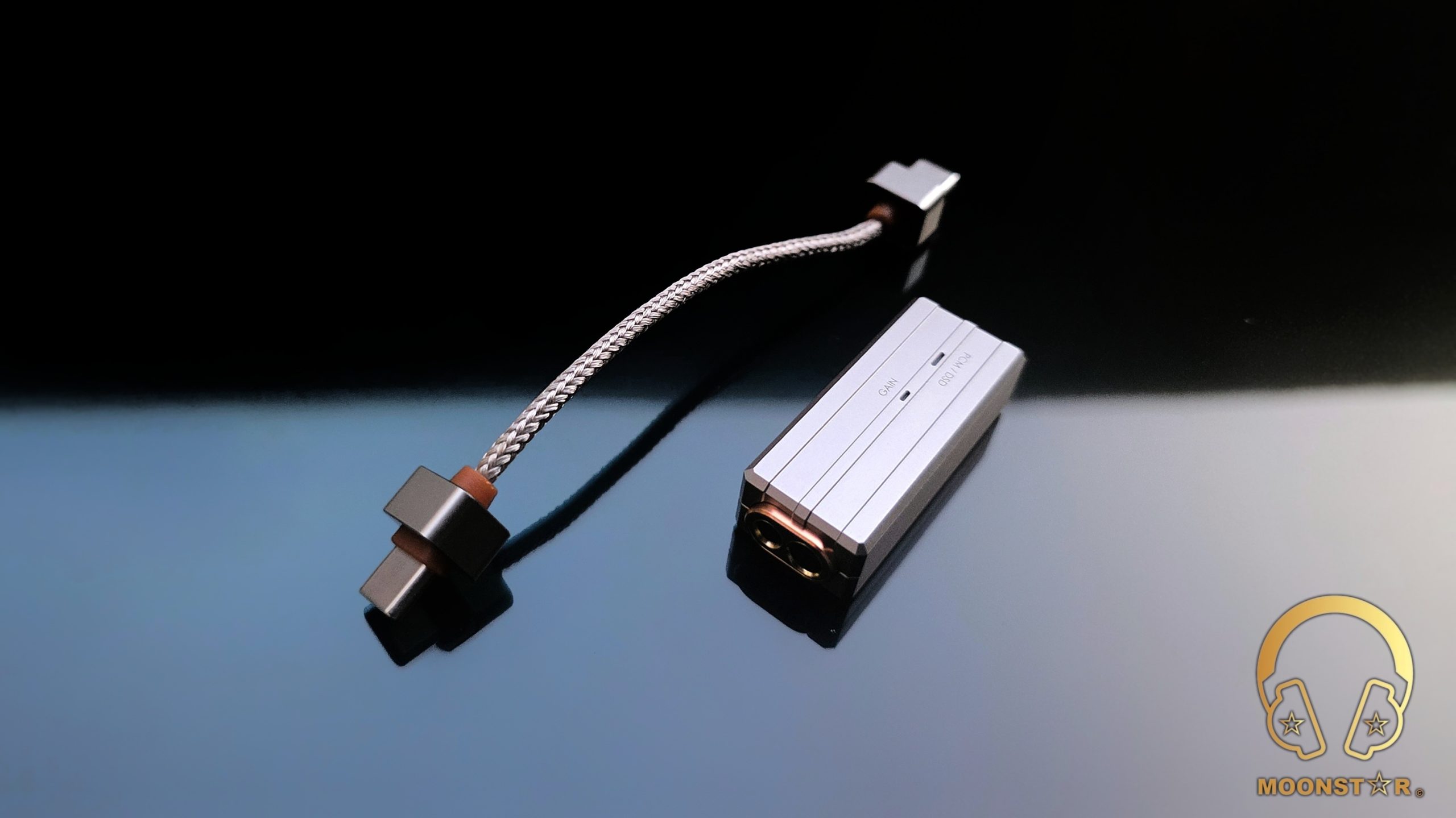
The Sound:
The Eye3 delivers a clean and neutral sound signature, prioritizing accuracy over coloration. It excels in providing a transparent window into the source material, with minimal added warmth or emphasis in any frequency band. This neutrality allows the inherent characteristics of the connected IEMs, such as the ddHiFi Surface and Moondrop Harmon, to shine through without alteration, making it an ideal tool for critical listening where fidelity to the original recording is paramount. During extended testing sessions, the device’s consistent performance across various genres highlighted its ability to handle complex mixes without introducing artifacts, ensuring that subtle nuances in recordings are preserved and presented faithfully.
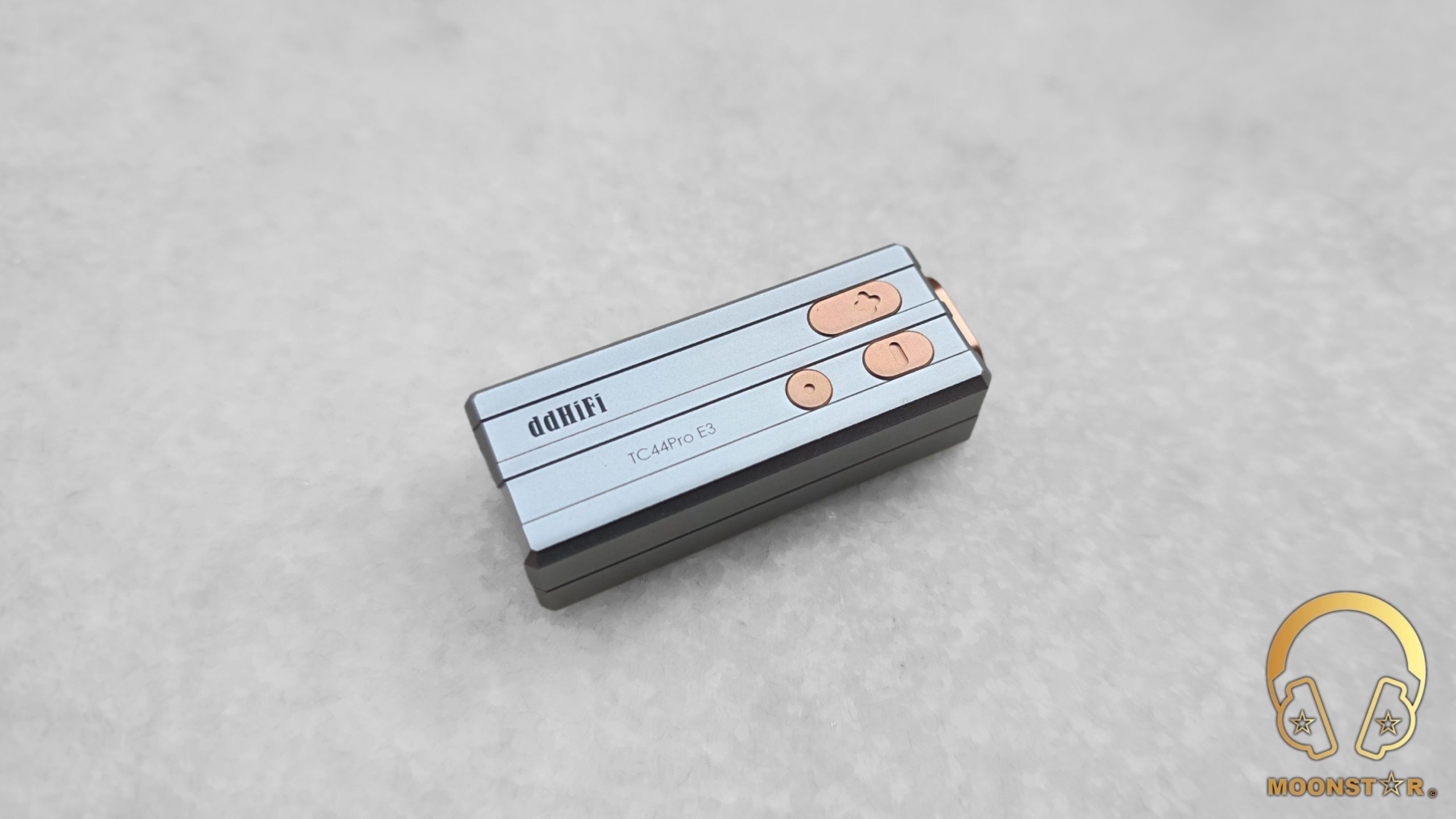
Bass:
The bass response is controlled and articulate, offering good extension into sub-bass regions without bloating or muddiness. On tracks with deep electronic pulses, such as Led Zeppelin’s “Kashmir,” the device maintains tightness, allowing for rhythmic precision that keeps the orchestral drums and bass guitar intact without smearing transients.
Mid-bass impact is present but restrained, ensuring it doesn’t overpower other elements, as evident in the punchy yet balanced low-end on Metallica’s “Sad but True,” where the kick drum and bass lines remain defined and integrated seamlessly with the guitars. For users with bass-light IEMs, this neutrality can highlight deficiencies, but with balanced setups like the ddHiFi Surface, which has a natural low-end roll-off, it provides a solid foundation that avoids exaggeration on Megadeth’s “Sweating Bullets,” emphasizing the bass riff’s texture. Similarly, when paired with the Moondrop Harmon, known for its tuned bass response, the Eye3 delivers sub-bass rumble in heavy tracks without veering into boominess, maintaining clarity even in dense arrangements. Overall, the bass handling promotes a sense of realism, with decay and texture rendered accurately, contributing to an engaging yet non-fatiguing experience across prolonged listening.
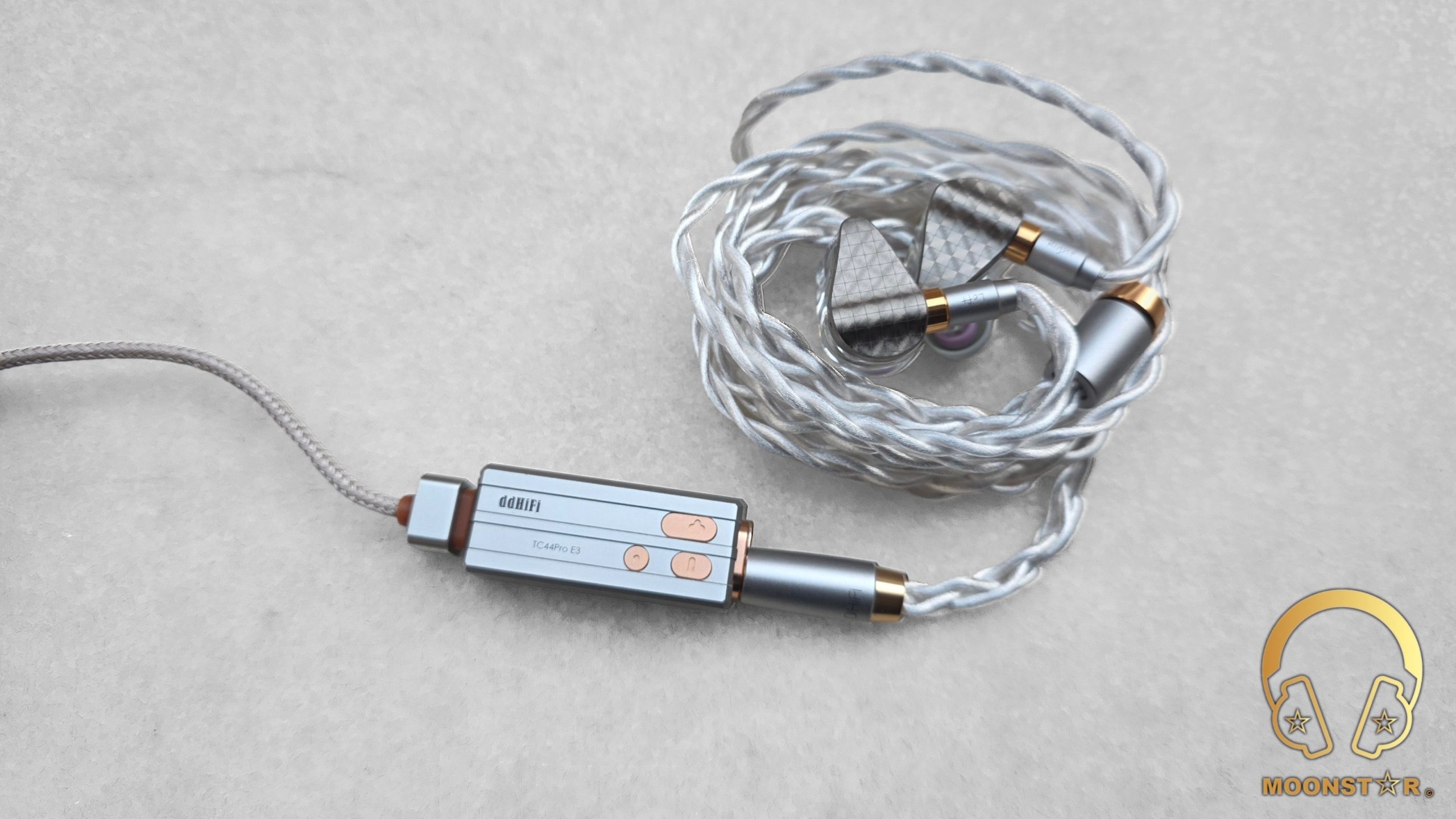
Midrange:
Mids are presented with clarity and natural timbre, making vocals and instruments sound lifelike. There is no forward push or recession, allowing for an even portrayal across the range that avoids any unnatural emphasis. Guitar tones retain their texture, and piano notes exhibit proper decay, as demonstrated in Elton John’s “Your Song,” where the piano’s resonant body and vocal inflections come through with impressive detail and emotional depth.
The overall midrange tunning avoids harshness, contributing to fatigue-free listening during extended sessions, particularly noticeable in vocal-heavy tracks like David Bowie’s “Black Star,” where the breathy delivery and subtle guitar layers are conveyed with intimacy and precision. When using the ddHiFi Surface, the midrange gains a slight airiness that enhances instrument separation on Eric Clapton’s “Layla,” highlighting the dual guitar interplay. While the Moondrop Harmon adds a touch of warmth to vocals without compromising neutrality, making acoustic recordings feel conversational and immersive. This section of the frequency spectrum benefits from the device’s low distortion, ensuring that harmonic overtones in instruments like guitars or pianos are reproduced faithfully, resulting in a cohesive sound that draws the listener into the performance rather than distracting with anomalies.
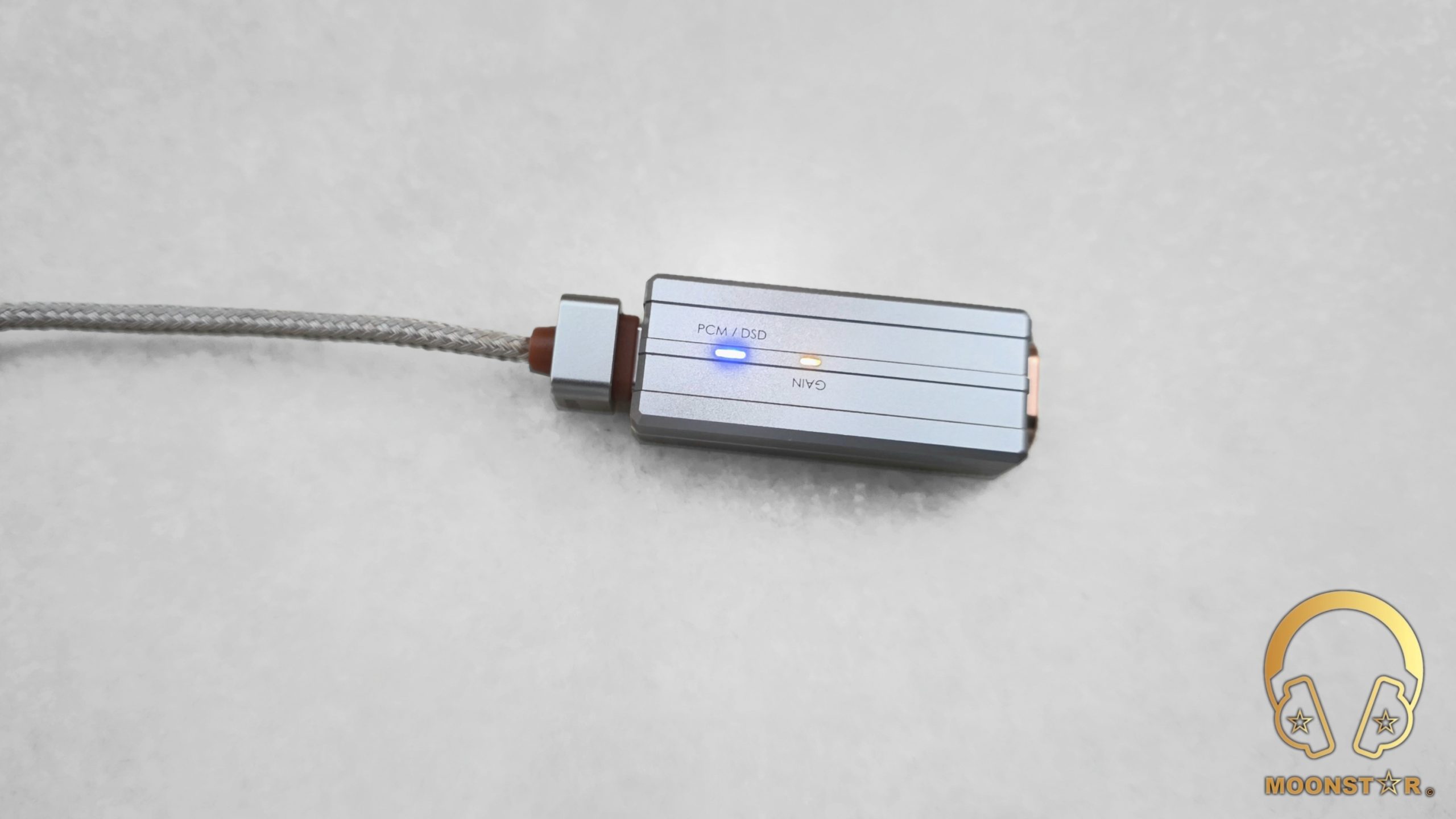
Treble:
Treble extension is smooth and detailed, with sparkle that enhances airiness without sibilance. Cymbals and high-frequency details emerge cleanly, supporting complex arrangements such as the intricate strings in Vivaldi’s “Le Quattro Stagioni,” where violins shimmer without piercing sharpness.
The upper end remains composed, preventing fatigue even on brighter recordings, as seen in the crisp yet controlled high notes of Otto Liebert & Luna Negra’s “The River,” preserving the natural decay of guitar strings without artificial extension. Paired with the ddHiFi Surface, the treble takes on a refined quality that highlights micro-details in ambient sounds on Gogo Penguin’s “Raven,” emphasizing cymbal crashes. While the Moondrop Harmon tempers any potential brightness, ensuring a balanced presentation that suits extended classical or jazz sessions. This controlled approach to highs contributes to an overall sense of openness, allowing for better perception of spatial cues in recordings without introducing glare or roll-off, making it suitable for analytical listening where every nuance matters.
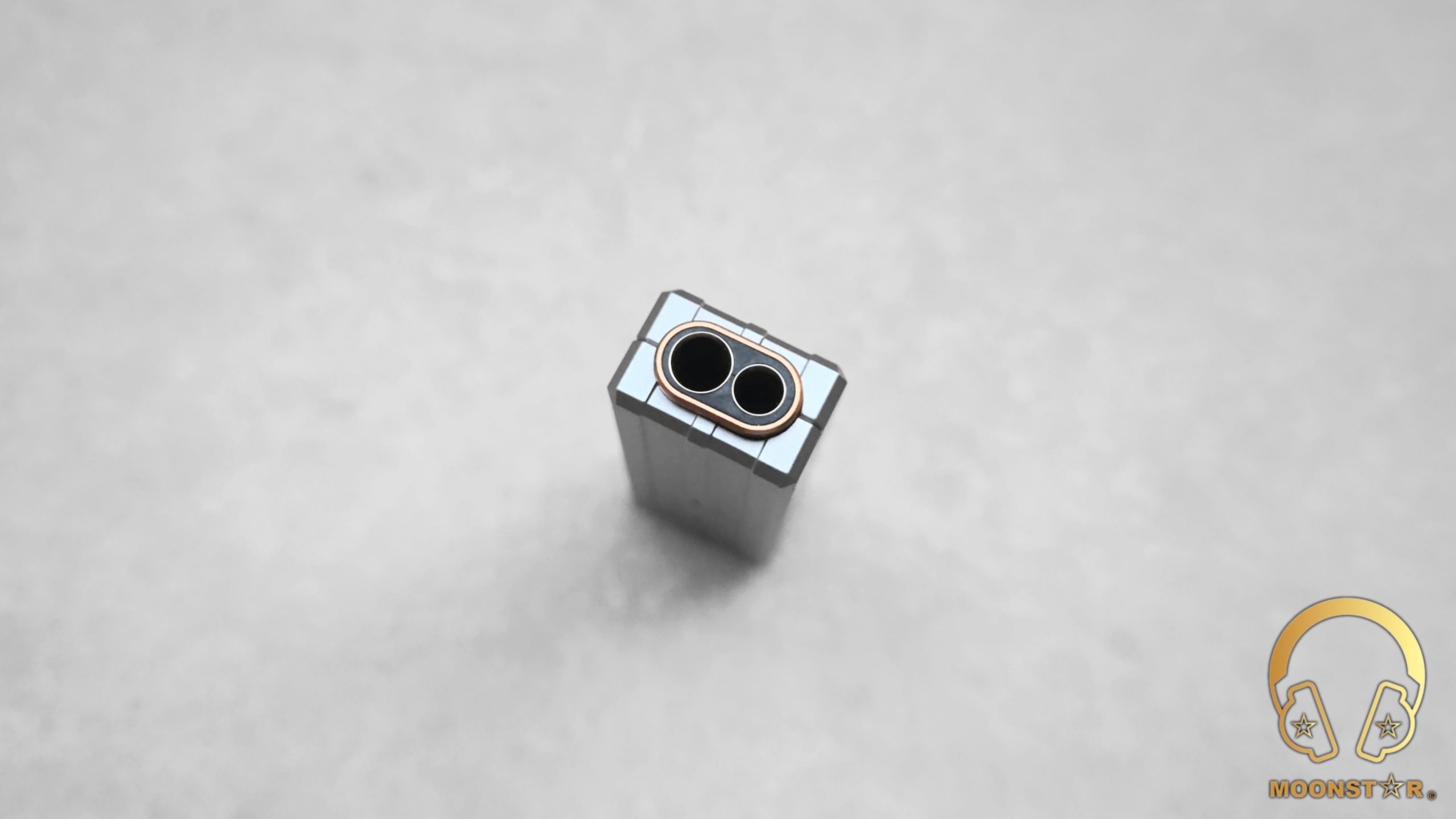
Soundstage & Imaging:
The soundstage is moderately wide, with good depth and height for a dongle of this size. Imaging is precise, placing instruments accurately within the stereo field, where the solo instruments occupy a central, focused position amid subtle acoustics. Separation between channels is strong, aided by the balanced output, though the single-ended port offers slightly less expansiveness, which was apparent when switching connections during tests, where instrument placement remained pinpoint despite the change.
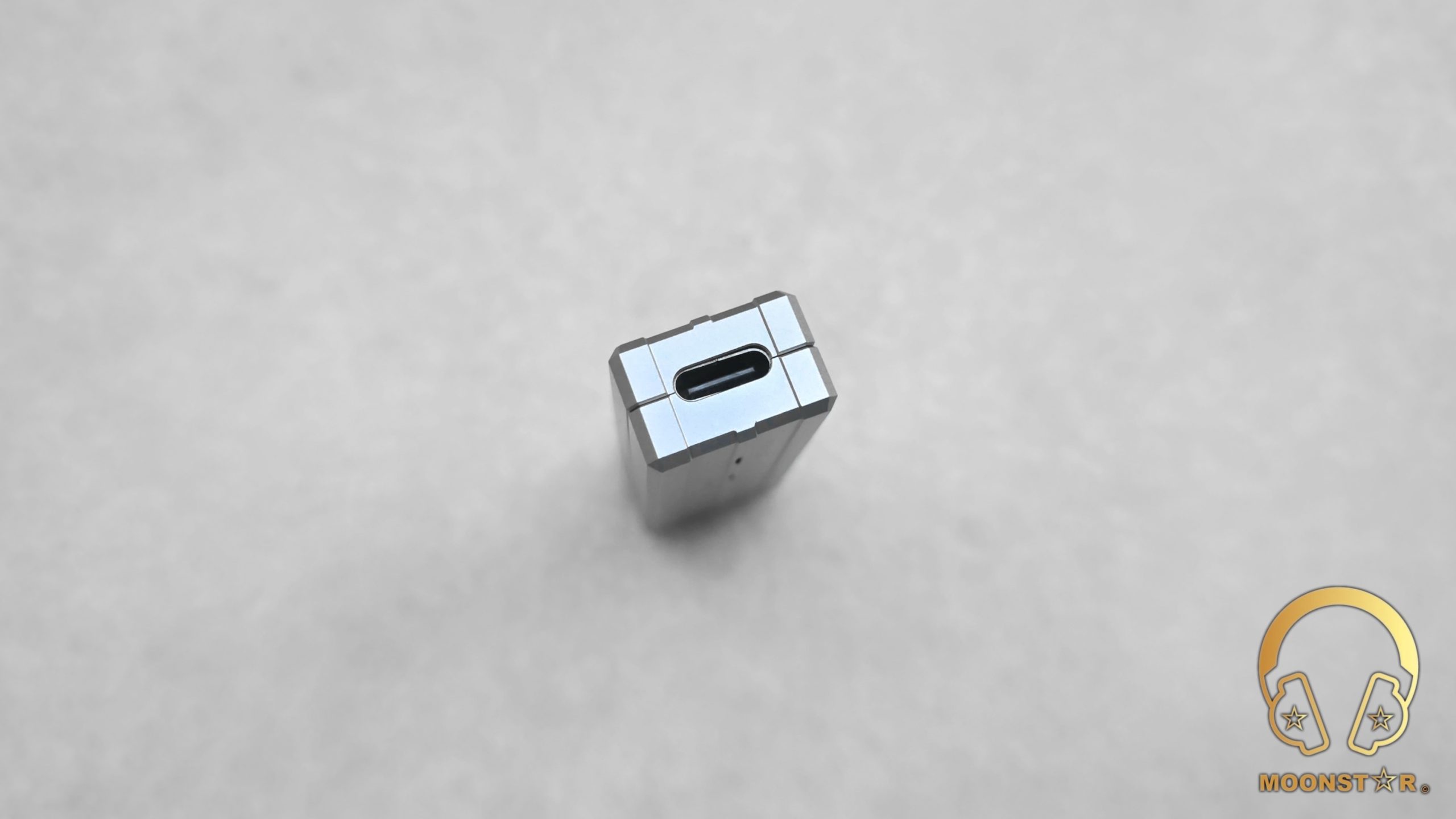
Conclusion:
The ddHiFi Eye3 (TC44Pro E3) stands out as a strong contender in the portable DAC/AMP market, balancing a compact form factor with capable audio performance. Its durable, premium build and thoughtful design, including physical volume controls and a gain switch, contribute to a user-friendly experience. The inclusion of both 3.5mm and 4.4mm outputs provides versatility for a wide range of headphones and in-ear monitors.
From an audio perspective, the device maintains a neutral and transparent sound signature. It reproduces bass with control and definition, presents midrange frequencies with clarity, and offers a smooth yet detailed treble response. The soundstage is presented as moderately expansive, with clear instrument separation and accurate imaging. While it may lack some of the advanced features found in larger desktop units, its focus on core functionality and sonic fidelity makes it a viable solution for those seeking a portable upgrade to their listening experience. Overall, the Eye3 delivers on its promise of high-resolution audio in a discreet, portable package.

Pros & Cons:
- + Neutral sound signature with excellent clarity and detail.
- + Compact and lightweight design for ultimate portability.
- + Small Footprint
- + Impressive output power for its size, especially on balanced connections.
- + Versatile compatibility across devices and formats.
- + Precise volume and gain controls for fine-tuned listening.
- – Lacks additional features like EQ or Bluetooth connectivity.
- – High-gain mode can introduce minor noise with ultra-sensitive IEMs.
Thank you for the Read

